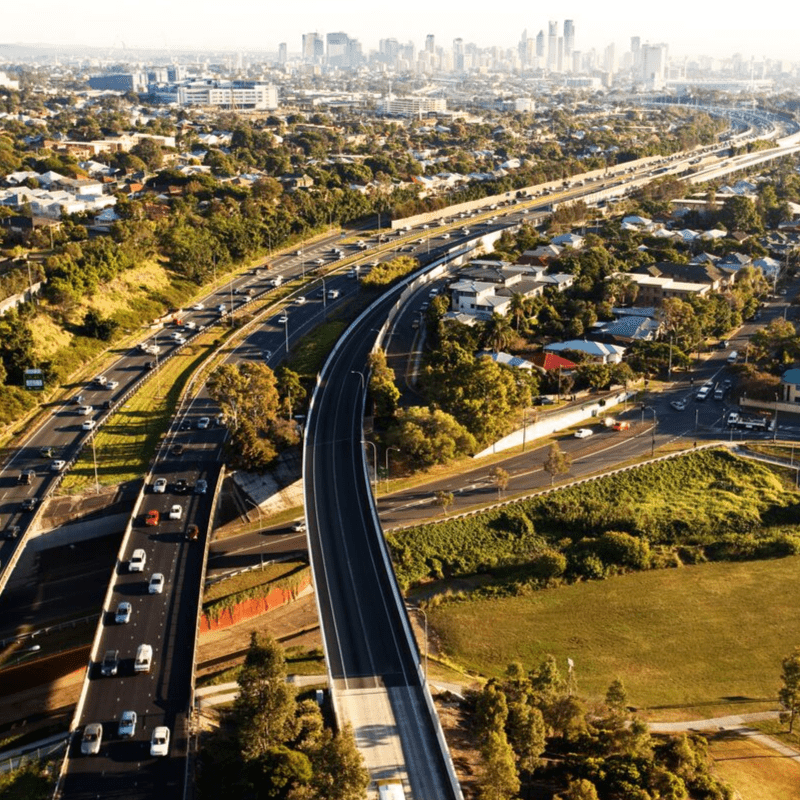Driverless cars: What the future holds
Autonomous vehicles and eventually driverless cars are coming, and they’re set to stay.
Despite its use and acceptance is not widespread today, most major car manufacturers and technology companies are investing, exploring and wrangling with regulators and public perception to bring autonomous vehicles onto our roads, all over the globe.
Increased safety is the priority and primary benefit, with insurers playing a critical role in the transition to this driverless future.
Here’s what the future holds, according to QBE’s autonomous vehicle expert and National Product Manager for Private Motor, Dennis Woon.
What is a driverless car?
A driverless car is exactly that, a car without a human driver. While we’re quite a number of years if not decades away from driverless cars dominating our roads, we’re already getting a glimpse of what this future holds today.
Driverless cars are more accurately described as a subdivision of autonomous vehicles. There are various ways in which autonomous vehicles are differentiated but the most widely adopted definition is SAE’s International Levels of Automation.
There are five levels of autonomy:
- Level 0: The car monitors the road and provides warnings, but the driver is still responsible for reacting to these warnings. Examples include blind spots, lane departure or collision warnings
- Level 1: The car starts to play an active role in safety to reduce the severity of or prevent crashes controlling either the steering or the gas/brake pedal. Examples include Adaptive Cruise Control, Autonomous Emergency Braking (AEB) and Lane Keep Assist
- Level 2: The car plays a more active role in safety through controlling multiple systems in certain circumstances. An example of this is Active Cruise Control and Lane Keeping Assist used on a highway. The driver still has to pay attention and maintain overall control of the car
- Level 3: The car is able to drive on its own in certain scenarios, such as highways, without a driver having any input into the control. The challenge with Level 3 is that the driver still has to pay attention to the road and be ready to take over control in the event the car ‘can’t manage’. A unique Australian example of this today would be if a kangaroo suddenly jumped in front of your car
- Level 4: An extension of Level 3, however this level doesn’t require the driver to be ready to take control. In the event the vehicle enters an environment in which it “can’t manage”, it has the ability to come to a safe stop
- Level 5: Essentially the “driverless car” which will be able to function on its own, without a human required to intervene control at any point. It will take some time to get to a point where driverless cars roam our streets but we’re definitely on the pathway towards that future
Will driverless cars be safer?
Advancements in car design and construction, crash testing and safety features like seat belts, air bags and ABS technology have made cars today safer than they have ever been since they were first introduced over 100 years ago.
Despite this, nearly 1.25m people around the world die in road crashes each year.
Human error contributes to over 90 per cent of road accidents and a contentious view is that cars will never be completely safe so long as there’s a human driver in control. Human drivers are susceptible to being distracted or fatigued - factors that an autonomous vehicle will never have to contend with.
Autonomous vehicles will be able to monitor the environment in a holistic way using an array of sensors, cameras and guidance systems. Sophisticated machine learning systems will be able to analyse all the data collected from these sensors and make quick decisions to minimise and prevent crashes altogether. From this perspective, autonomous vehicles are likely to be safer.
There are other perspectives however, arguing that although autonomous vehicles may be safer as a result of the data collected from the sensors and systems, we could see more road accidents when autonomous vehicles interact with human driven vehicles given the inherent behavioural differences between the two.
An example of this is the potential conflict on the road when an autonomous vehicle is programmed to follow road rules exactly when at the same time, humans may not follow the road rules.
One myth that often misleads Australian drivers is that you must always give way to your right when nearing a roundabout, when actually the rule in all Australian states and territories is to give way to anyone who enters the roundabout before you.
In this scenario, traffic may be impeded, or a collision could occur if there’s a discrepancy between the rules for an autonomous vehicle and a human driver regarding the right of way when entering or approaching a roundabout.
If we made all cars driverless - after the technology had been tried, tested and proven - and removed the ability for humans to take control, we could see a significant reduction in crashes. However, there is a real sense of uncertainty around the interaction of autonomous vehicles and human driven vehicles.

Will driverless cars takeover?
Perhaps, but the capability of autonomous technology is unlikely to influence the speed that driverless cars ‘takeover’. Instead, it will be government regulation, policy and most importantly, people wanting to get into an autonomous vehicle that will be key.
Despite car manufacturers and technology companies spending billions to put autonomous vehicles on to roads, a recent MIT study found people might not really want them.
The study asked nearly 3,000 people about their interest in self-driving cars. Nearly half – 48 percent – said they would never purchase a car that completely drives itself.
Respondents said they're uncomfortable with the loss of control and don't trust the technology. They also don't feel self-driving cars are safe.
Young people are still more comfortable with autonomous vehicles than older people, according to the study, but they're becoming more cautious about the technology.
However, a research scientist at MIT's AgeLab, Bryan Reimer, said people do want some autonomous technology in their cars — such as automatic emergency braking, lane-keeping systems and auto-park features.
Will driverless cars reduce accidents?
Early studies into Level 1 and 2 autonomous vehicle technologies are showing promising results.
A recent study conducted by the Insurance Institute for Highway Safety (IIHS) of General Motors revealed that cars with autobrake and forward collision warnings had 43 percent fewer police-reported front-to-rear crashes of all severities and 64 percent fewer front-to-rear crashes with injuries than the same vehicles without any front crash prevention technology.
Driverless cars are likely to reduce the number of accidents where human error was a contributing factor, what is uncertain however is new or different types of accidents that may emerge in a world of autonomous vehicles. Another important factor to consider is that the laws of physics still apply to a car whether it’s driven by a human or a sophisticated computer.
Will driverless cars be electric?
While Australia lags other developed countries in adopting electric vehicles, we are definitely seeing a push for these types of vehicles at a global level.
Many European nations are already committed to exiting both diesel and petrol engines and this trend is set to continue into the next decade.
There are a number of alternative engine power sources to being explored to replace the traditional combustion engine, with Electric Vehicle (EV) technology seemingly leading the race it’s very likely that driverless cars will be powered by an electric engine.
If the future plays out this way, then driverless cars could be better for the environment.
Will driverless cars reduce traffic?
There’s a lot of debate about this. On one hand, autonomous vehicles could reduce traffic as driverless cars can be more easily shared within families and possibly small communities, there is less of a need for people to have their own car to get around. As a result, we could see less car ownership and reduced traffic.
On the other hand, cars today are generally underutilised, with vehicles only on the road up to 5 per cent of the time . Driverless technology could maximise a cars lifespan by being on the road more often rather than being parked for long periods of time. This leads to the view that driverless vehicles could actually increase congestion.
Whether driverless cars reduce traffic or not will depend on how car ownership and usage models evolve over the next few decades.
Will driverless cars require a driving license?
We could see different types of driving licenses over time, but so long as there’s any ability for human intervention in the control of the car, it’s difficult to see the rationale to remove licensing completely.
It’s too early to presume that even a fully driverless car, capable of navigating all types of roads, won’t have a steering wheel or pedals. It’s possible that these cars could still have some form of control where a human could take over. In these circumstances, licensing would still be necessary.

Will driverless cars be mandatory?
Essentially this would mean that no human being would be allowed to drive a car on a public road. A decision of this scale would require unquestionable proof that autonomous vehicles can manage all types of roads, weather conditions and possible scenarios. Even if we were to achieve that, the more important question would be around whether the community will accept this.
We are very far away from Level 5 autonomous vehicles becoming the ‘norm’, let alone these vehicles being mandatory. There’s still a lot that the technology has to figure out.
I think any shift towards mandating driverless cars will require generational change.
We’re at the start of what is the biggest evolution of the car as we know it today with current generations having grown up to view the concept of the car as something we drive and control.
Changing this view won’t happen overnight. Future generations may even question why we were allowed to drive a car or why we ever wanted to in the first place.
Will driverless cars need insurance?
Yes, because there will still be hail storms and floods, and it’s likely that theft and vandalism will still occur to some extent.
Even decades from now with the most advanced autonomous vehicles on our roads, accidents will still happen, there will just be less occurrences of cars running into other cars.
As much as autonomous vehicles will likely reduce the risk of crashes, it does introduce new risks some of which we might be aware of today such as cyber security risks, and others which we’ve yet to identify.
Insurance will evolve and continue to play a role in autonomous vehicle much as it’s played a role in the evolution of the ‘car’ over the last century.
Will driverless cars be expensive?
Like any new technology introduced for mass consumption, it will initially be expensive, but will become affordable over time as scale and efficiency to produce these technologies increases. Autonomous vehicles are no different and over time we should see these features as standard in cars and possibly mandatory in some cases.
We’re already seeing this today with autonomous vehicle related technologies like Autonomous Emergency Braking (AEB) or Adaptive Cruise Control (ACC). These features were only available on expensive, high-end luxury vehicles a few years ago but now a standard feature in sub $20,000 cars.
As the safety benefits of autonomous vehicle technology become clearer, we could even see some of these features become a mandatory requirement for vehicles before they’re allowed into Australia.
For example, airbags and seat belts weren’t always mandatory. Rather, they were optional features only available in the premium or prestige range of certain models of cars
The concept of the modern seat belt was first developed in the 1950’s and were offered as optional features in cars up through the 1960’s and were eventually made compulsory in Australia in 1970 It’s hard to imagine any car today without a seat belt.
Will driverless cars have steering wheels?
Autonomous vehicles will likely continue to have steering wheels and pedals until governments legislate that it’s no longer safe to have humans in control of vehicles, according to Woon. US car manufacturer, General Motors (GM) is already seeking to introduce a self-driving car without a steering vehicle or any other human controls including brake or gas pedals.
However, the US National Highway Traffic Safety Administration (NHTSA) has delayed action for 15 months on the manufacturers request to deploy a test fleet of 2,500 vehicles on US roads – likely San Francisco - without human manual controls.
As part of General Motor’s petition, the NHTSA will compare a vehicle in which all driving decisions are made by a computer vs a human driver for the first time. GM must demonstrate the vehicles are at least as safe as human-driven vehicles to win temporary exemptions from the requirements.

How will driverless cars affect insurance?
One of the main challenges impacting insurance revolves around the question of fault when an accident occurs, which becomes complex when human error is exchanged for a machine learning environment. The way ‘fault’ is determined for autonomous vehicles is something that’s still being worked through with different points of view. This will take time to resolve and continue to evolve as the technology does.
In the immediate term, there is already work being done by insurers and regulators assessing how autonomous vehicles will impact Compulsory Third Party (CTP) Insurance.
CTP insurance covers the cost of third party compensation claims, if you, or anyone driving your car, causes an accident in which someone else is injured.
We need to make sure that people who are injured in an accident involving an autonomous vehicle won’t have a complex pathway to compensation, recovery and access to treatment compared to someone who has an accident with a human vehicle.
Above all else, the current insurance model must survive the transition from Level 1 through to Level 5 vehicles. Insurance will fail in this challenge if we have a different insurance model for autonomous vehicles than we have for traditional vehicles.
In the meantime, and despite the uncertainty, the insurance industry’s support of trials is important for the transition towards autonomous vehicles. Being visible in this way is important as it’s telling the community that insurance is here, supporting the technology and we want to see autonomous vehicles on the road.
This brings us back to the ecosystem of how the security of insurance cover can aid with community acceptance, and with government feeling confident to allow the vehicles on the roads.
How will driverless cars affect society?
Autonomous vehicles will change the nature of how society operates as we know it today as we become a more mobile society.
If people are able to take their eyes off the road, we can have productive journeys. Cars will be regarded as essentially an extension of your home or office. The need for multiple cars per family may reduce as a single driverless car can perform multiple drop-offs and pick-ups for the family and possibly even small communities.
This shift in mobility extends to infrastructure planning and how we construct roads, streetscapes, infrastructure, major transport and entire cities.
Eventually, we could also see changes to the typical suburban home, for example, the conversion of garages into rooms, or connecting our cars seamlessly to integrate with a smart home.
Car design won’t be in isolation to our home or working spaces.









